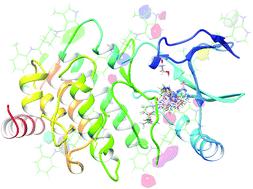当前位置:
X-MOL 学术
›
New J. Chem.
›
论文详情
Our official English website, www.x-mol.net, welcomes your
feedback! (Note: you will need to create a separate account there.)
Development of novel therapeutics for the treatment of glaucoma based on actin-binding kinase inhibition – in silico approach
New Journal of Chemistry ( IF 2.7 ) Pub Date : 2020-04-06 , DOI: 10.1039/c9nj05967a Maja Zivkovic 1, 2, 3, 4, 5 , Marko Zlatanovic 5, 6, 7 , Nevena Zlatanovic 4, 5, 8 , Jasmina Djordjevic Jocic 1, 2, 3, 4, 5 , Mladjan Golubović 4, 5, 7, 9 , Aleksandar M. Veselinović 1, 3, 5, 10, 11
New Journal of Chemistry ( IF 2.7 ) Pub Date : 2020-04-06 , DOI: 10.1039/c9nj05967a Maja Zivkovic 1, 2, 3, 4, 5 , Marko Zlatanovic 5, 6, 7 , Nevena Zlatanovic 4, 5, 8 , Jasmina Djordjevic Jocic 1, 2, 3, 4, 5 , Mladjan Golubović 4, 5, 7, 9 , Aleksandar M. Veselinović 1, 3, 5, 10, 11
Affiliation

|
Actin-binding kinases are enzymes involved in the regulation of actin polymerization and microtubule disassembly. The inhibition of actin-binding kinases can be used in the treatment of glaucoma, since it relaxes the tissue, increases outflow facility, and reduces intraocular pressure. This study presents quantitative structure–activity relationship (QSAR) modeling for a group of 59 chemical compounds, actin-binding kinase inhibitors. The modeling was based on the Monte Carlo optimization with molecular descriptors based on the simplified molecular-input line-entry system notation and local invariants of the molecular graph, as well as on 3D field-based methods. Conformation independent QSAR models were developed for three random splits, whereas the 3D QSAR model was developed for one random split into the training and test set. Regarding the statistical quality of the developed models, including robustness and predictability, it was tested using numerous statistical approaches and the obtained results proved good. There was an excellent correlation between the results from the 3D QSAR and conformation independent models. In addition, a new statistical metric – the index of ideality of correlation was applied for the final assessment of the model, and the results were good. Molecular fragments responsible for the increases and decreases of a studied activity were defined and used for the computer-aided design of new compounds as potential actin-binding kinase inhibitors. The final assessment of the developed QSAR model and designed inhibitors was done using molecular docking studies, which were in excellent correlation with the results from QSAR modeling.
中文翻译:

基于肌动蛋白结合激酶抑制作用的新型治疗青光眼的药物的开发–计算机方法
肌动蛋白结合激酶是参与调节肌动蛋白聚合和微管分解的酶。肌动蛋白结合激酶的抑制作用可用于青光眼的治疗,因为它可使组织松弛,增加流出设施,并降低眼内压。这项研究为一组59种化合物(肌动蛋白结合激酶抑制剂)提供了定量构效关系(QSAR)模型。建模基于蒙特卡洛优化,其中带有基于简化的分子输入线输入系统符号和分子图局部不变量的分子描述符,以及基于3D场的方法。针对三个随机分割开发了与构型无关的QSAR模型,而针对一个随机分割开发了3D QSAR模型,将其分为训练和测试集。关于已开发模型的统计质量,包括鲁棒性和可预测性,已使用多种统计方法对其进行了测试,并证明了结果良好。3D QSAR结果与构象独立模型之间存在极好的相关性。此外,新的统计指标–相关理想性指数被用于模型的最终评估,效果良好。确定了负责研究活性增加和降低的分子片段,并将其用于新化合物的计算机辅助设计,作为潜在的肌动蛋白结合激酶抑制剂。使用分子对接研究对已开发的QSAR模型和设计的抑制剂进行了最终评估,这些研究与QSAR建模的结果非常相关。
更新日期:2020-04-06
中文翻译:

基于肌动蛋白结合激酶抑制作用的新型治疗青光眼的药物的开发–计算机方法
肌动蛋白结合激酶是参与调节肌动蛋白聚合和微管分解的酶。肌动蛋白结合激酶的抑制作用可用于青光眼的治疗,因为它可使组织松弛,增加流出设施,并降低眼内压。这项研究为一组59种化合物(肌动蛋白结合激酶抑制剂)提供了定量构效关系(QSAR)模型。建模基于蒙特卡洛优化,其中带有基于简化的分子输入线输入系统符号和分子图局部不变量的分子描述符,以及基于3D场的方法。针对三个随机分割开发了与构型无关的QSAR模型,而针对一个随机分割开发了3D QSAR模型,将其分为训练和测试集。关于已开发模型的统计质量,包括鲁棒性和可预测性,已使用多种统计方法对其进行了测试,并证明了结果良好。3D QSAR结果与构象独立模型之间存在极好的相关性。此外,新的统计指标–相关理想性指数被用于模型的最终评估,效果良好。确定了负责研究活性增加和降低的分子片段,并将其用于新化合物的计算机辅助设计,作为潜在的肌动蛋白结合激酶抑制剂。使用分子对接研究对已开发的QSAR模型和设计的抑制剂进行了最终评估,这些研究与QSAR建模的结果非常相关。











































 京公网安备 11010802027423号
京公网安备 11010802027423号